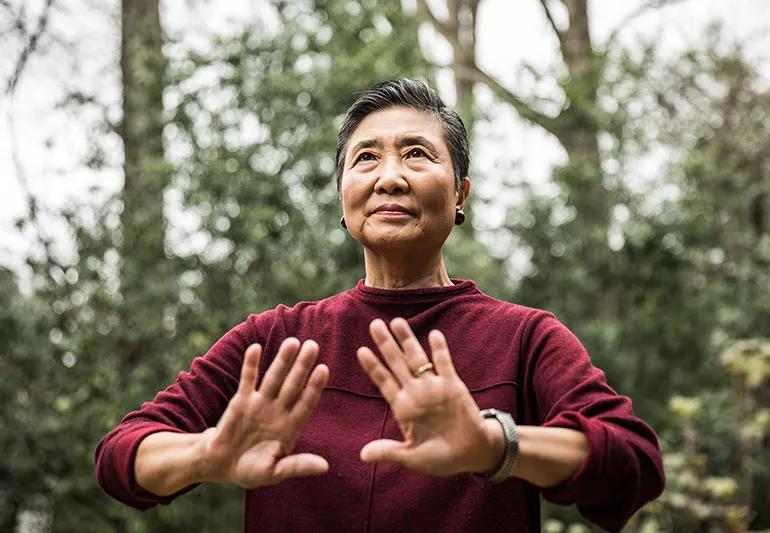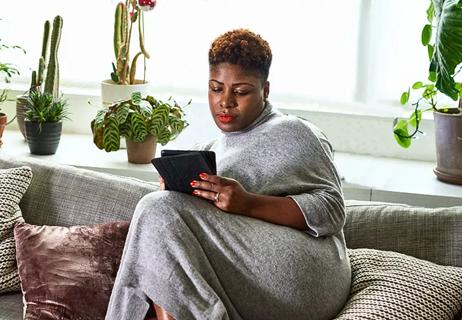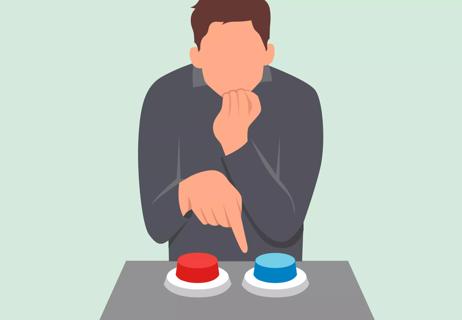
If we’ve learned anything in the last few years, it’s that tending to our mental health is as important as taking care of our physical health. Regular exercise certainly gives us a brain and body boost, as does maintaining a healthy diet. But meditation is also becoming an increasingly popular way to nurture your whole self.
Advertisement
Cleveland Clinic is a non-profit academic medical center. Advertising on our site helps support our mission. We do not endorse non-Cleveland Clinic products or services. Policy
“You’ve probably heard that meditation is good for you, just like you’ve heard that yoga or tai chi is good for you,” says yoga therapist Sally Sherwin, E-RYT 500, C-IAYT. “Maybe you’re not quite sure why. But, more and more, we have people open to the idea that there’s more to a wellness journey than just taking medication.”
Meditation might seem mysterious or time-consuming if you’re unfamiliar with the practice. It’s quite different from what you might think it is, though. “A lot of people have the idea that it’s sitting in a pretzel pose on a hardwood floor, closing your eyes and clearing your mind of thoughts,” Sherwin says. “But that’s really not it.”
There’s no one right way to meditate, and meditation can take on many forms. At its core, however, the practice “helps calm your mind and develop the ability to stay in the present moment,” Sherwin explains. “You’re not thinking about things that happened yesterday that still bother you, or dwelling on anxiety about future things, like looming deadlines and long to-do lists.”
Meditation is more than just getting yourself into a particular state of mind, though. “It’s more about an effortless focus,” Sherwin says. “Some people define meditation as concentration, but the word ‘concentration’ to me sounds like work. And we don’t need any more work in our lives, that’s for sure.”
Advertisement
There isn’t one correct type of meditation. You can do it while seated or lying down, or while doing a physical activity like yoga or tai chi. “There really are a wide range of different kinds of practices,” Sherwin says. “In the yoga tradition, meditation typically means focusing on a single point of awareness. But there are other meditations where you may just open to everything around you such as different sounds outside and inside the room, or your five senses — what you smell or feel.”
Getting into a proper mindset for meditation is important to successful practice. “One of the first things I always ask people is, ‘What do you think meditation is?’” Sherwin says. The responses tend to differ, she adds, but often involve people giving excuses why they can’t meditate.
“All sorts of answers come up, like, ‘Well, I can’t do it because my mind’s too restless,’” Sherwin says. “That’s like saying you have to be fit to go to the gym. Or ‘I don’t have time.’ If you really stop and think about how much you check your email or texts, everybody’s got time.” In other words, a positive attitude goes a long way to helping you get ready to meditate.
Here are some other specific types of meditation:
Breath meditation is both simple and versatile. “There are all sorts of studies that show when you breathe better, you feel better,” says Sherwin. “Your body works better. Slow, deep breaths activate the body’s relaxation response and reduces chronic stress.”
In this type of meditation, you’re focusing on the very act of inhaling and exhaling. “You’re bringing awareness to the natural process of breathing,” she adds. “So it’s giving your mind something to do. You’re following the in breath, and you’re following the out breath.”
Taking deeper breaths can provide many surprising health benefits. “If you’re breathing more deeply, you’re getting much more oxygen to the brain,” Sherwin says. “You’re also releasing much more carbon dioxide on your exhale, which is good for releasing toxins in the body.”
Breathing deeply also has a positive impact on your concentration, creativity and problem-solving skills, she adds. “Something as simple as breathing better can help you in so many ways. It’s profoundly effective.”
Mindfulness is “about paying attention and focusing in the right here and right now,” Sherwin says. “You’re not thinking about the past or the future. You’re in the current moment.”
Advertisement
In this type of meditation, you’re typically drawing on multiple stimuli (all of your senses) to help you stay in the present and observe what’s going on around you and how you feel. “Mindfulness asks you to use all your senses to check in,” Sherwin says. “What does your body feel like? Does something feel tight? What kind of thoughts and emotions are you having?”
In guided imagery meditation, a teacher (in person, online or even using an app) guides you on a mental journey through relaxing mental images or memories. These might include a vacation you enjoyed, a fun date with your partner or a time when you were blissfully happy.
“Using these mental images guides you into places that you recognize,” Sherwin says. “They’re memories that bring a smile to your face. For example, if you’re remembering your favorite vacation, it reminds you that the trip was a great way to relax and recharge. You have all sorts of positive associations with it.”
To help guide you back to that place, your teacher might ask leading questions that involve all of your senses. “Are you somewhere where the trees smell like pine?” Sherwin says. “Are you feeling warm, sugary sand beneath your toes? Do you hear ocean waves or maybe, a cool, clear brook?”
Advertisement
Yoga nidra, which is sometimes called yogic sleep, is a slightly different type of meditation. It’s a little longer of an experience, roughly 30 minutes, and you’ll typically lie on the floor for it. It’s also a guided practice, meaning someone else is helping you along the meditation journey.
“You don’t really go to sleep, and you are still aware,” Sherwin explains. “But it’s really an enhanced state of relaxation and awareness. You’re able to access deeper brainwaves, the kind of brainwaves that occur during deepest sleep cycles.”
The loving-kindness meditation, also known as the metta meditation, involves applying a statement of gratitude to various people and situations in your life. “The traditional wording is, ‘May I be well, may I be happy, may I be peaceful, may I be loved,’” Sherwin says. “It helps us take our limited worldview and expand it out to global well-being.”
After starting by saying this statement to yourself, you’ll then do the same for a loved one or someone close to you: “May you be well, may you be happy, may you be peaceful, may you be loved.” Next, Sherwin says to apply this wording to your bigger circle of friends and acquaintances — for example, the barista you see every day — and then gradually use the practice on difficult people in your life.
Advertisement
“If there’s someone who pushes your buttons, wish them well, wish them happiness,” Sherwin says. “It’s a profound practice in cultivating kindness and forgiveness, and to get some space in that relationship with somebody whom you find difficult.”
In the final repeating of these phrases, you extend the meditation to beings everywhere and say, “May we be well, may we be happy, may we be peaceful, and may we be loved.”
As this name implies, moving meditations occur at the same time you’re doing an activity like yoga, tai chi or even walking. “For some people, an easier way for them to step into a meditation practice is by gentle movement,” Sherwin explains. “Eventually, as they’re moving, they’re beginning to focus their mind and quiet their thoughts.”
These meditations can be hybrids, or combinations. For example, mindfulness-based stress reduction is a formal practice that combines mindfulness practice with yoga.
According to Sherwin, there are currently more than 1,500 research studies discussing the benefits of meditation. “There’s hard science that backs up how beneficial meditation is,” she says. “You can experience some pretty profound changes with meditation, especially in conjunction with integrative and lifestyle medicine.” Some studies on the benefits of meditation were very small, however, meaning additional research might be needed to produce more conclusive results.
Meditation helps you deal with daily stresses. “You probably have an idea when you’re stressed or sense you live a fast-paced, stressed-out life,” Sherwin says. “What do you do about that? That’s where meditation comes in.”
Breath meditation especially helps you reduce your stress response. “If you’re feeling physically stressed out, tense and tight, or if you feel like you’re in a situation where you’re in over your head, a couple of deep breaths can really help,” Sherwin advises. “Doctors have found stress causes inflammation, and chronic inflammation is at the root of many diseases.”
It stands to reason that if meditation helps with stress, another side effect will be a decrease in anxiety. Based on a 2014 literature review of 47 trials, equal to 3,515 participants, mindfulness meditation programs at eight weeks showed “moderate evidence of improved” anxiety, depression and pain. However, that same review found there was scarce evidence of “improved stress/distress and mental health-related quality of life.”
According to a 2019 study, people who did a 13-minute daily guided meditation session for eight weeks had “enhanced attention, working memory and recognition memory.”
In a research study published in 2014, 54 people living with chronic insomnia had intensive meditation-based treatments based on mindfulness-based stress reduction or mindfulness-based therapy for insomnia. After eight weeks, the participants had a reduction in “total wake time and pre-sleep arousal” — meaning their sleeping habits were in a better place.
Meditation can feel daunting if you’ve never done it before. And some types of meditation aren’t easy to do on your own. For example, because guided imagery is always directed by someone else, Sherwin notes this type is “a little bit harder to do if you’re standing in line at the grocery store.”
Different types of meditation tend to have overlapping techniques, too — if you learn one kind, you’ll easily pick up another — and there’s likely a meditation practice you can do anywhere at any time.
“These mindfulness practices, or these meditations — whether it’s seated or whether it’s a moving meditation — can be done very simply,” Sherwin says. “They don’t have to involve special clothing or a special room or props. Just taking a deep breath throughout your day can help you to de-stress, can help you be present and reduce anxiety.”
You can practice meditation by yourself or within a group, such as a tai chi or a gentle or restorative yoga class. Online meditation apps are also tailored to your meditation style, whether you prefer a direct and matter-of-fact approach or calming techniques. Some apps even have an integrated chat room, so you can communicate virtually.
As you’re looking for the right meditation practice, Sherwin says it’s important to reflect on what approach suits you. “Avoid anything that tells you, ‘You have to meditate this way or that way,’” she says. “Or ‘This is the only right way to do it.’ There are many ways to meditate. Go with what resonates for you. There’s something out there that’s the perfect fit.”
It depends. While guided meditations require a time commitment, breath meditation can be done at any time, in short bursts. “You can meditate doing the dishes,” Sherwin says. What’s important is meditating regularly. “You can feel results immediately,” she adds. “But as little as eight weeks of daily practice gives you a more long-lasting benefit. An easy way to incorporate more mindfulness into your day is to connect with a routine you already have. Take a deep breath before brushing your teeth. Take a deep breath when fastening your seatbelt.”
Over time, the gains from meditation can sometimes be incremental or even unexpected. Sherwin notes that if you think meditation isn’t for you because you tried it and became frustrated because your mind was too restless — think again. “You’ve just had success in that meditation,” she says. “You realized, ‘Oh, wait, my brain is racing.’ You were aware in that present moment of what’s going on in the background and were able to tap into that knowledge. Normally we’re just running around on auto-pilot all the time.”
“Once you can recognize something — that’s, like, 95% of it,” Sherwin notes. “If you recognize that you’re stressed, well, then you can stop, take a deep breath and do something about it. You’ve got some tools to be able to deal with that stress, as opposed to just plowing on through.”
At the end of the day, the important thing about meditation is sticking with it long enough to make sure you can experience positive effects. “It’s great that there are so many different ways to meditate, but they all have the same goal: calming all those fluctuations of the mind and helping us be present and find some balance in our life,” Sherwin says. “We’re incredibly busy. Everybody’s stressed out. Relaxation and overall well-being are just some of the wonderful outcomes of a simple meditation practice.”
Learn more about our editorial process.
Advertisement

You don’t need to have years of experience to reap the rewards of meditation — with benefits for your whole body, you only need a couple minutes to get started

While walking, be mindful of your body, your mind, your place in the world and all five of your senses as you pave a path forward, one step at a time

Enter relaxation mode by managing your breathing, releasing muscle tension and practicing mindfulness

Thunder, waterfalls and heavy rain — these low-frequency sounds might help cancel out disruptive noises and thoughts

Immersing yourself in nature can improve both your mental and physical health

Don’t let the fear of making the ‘wrong’ decision stop you from moving forward

This bedtime exercise can help you fall asleep faster (and stay asleep)

Use this technique to increase awareness of your body and assess how you’re feeling

If you’re feeling short of breath, sleep can be tough — propping yourself up or sleeping on your side may help

If you fear the unknown or find yourself needing reassurance often, you may identify with this attachment style

If you’re looking to boost your gut health, it’s better to get fiber from whole foods